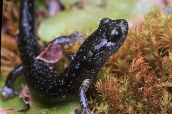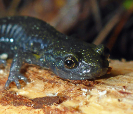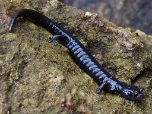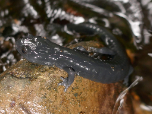Santa Cruz Black Salamander (Aneides niger)
Description: Adults measure 2 to 3 3/4 inches long from snout to vent, and up to 5.5 inches in total length. A medium-sized salamander with nasolabial grooves and well-defined costal grooves. Dorsal coloring is solid black, with a few fine white specks. Males have a broader head than females. Young are black with white speckles.
Habitat: Occurs in mixed deciduous woodland, coniferous forests, coastal grasslands. Found under rocks near streams, in talus, under damp logs, and other objects. Rarely encountered very far from water.
Range: This is the southernmost member of the A. flavipunctatus complex, and it is disjunct from all other members of the complex. It is restricted to the San Francisco Peninsula of California, where it inhabits San Mateo, Santa Cruz, and western Santa Clara counties.
Found in these States:
CA
Diet: Diet consists of a variety of small invertebrates, including millipedes, ants and termites. As salamanders grow larger, they eat fewer, but larger prey items.
Reproduction: Reproduction is terrestrial. Courtship and breeding behavior is not well known. Breeding males have a well-developed mental gland. Females probably lay from 8 to 25 eggs in moist cavities belowthe ground in July and August. Eggs are attached by peduncles. Females stay with the eggs until they hatch. Young develop completely in the egg and hatch fully formed.
Status: Listed as Endangered because its extent of occurrence (EOO) is 4,687 km2, it occurs in five or fewer threat-defined locations, and there is continuing decline in the extent and quality of its habitat.
Taxonomy: Originally described by George S. Myers and Thomas P. Maslin in 1948 as a subspecies of the speckled black salamander (A. flavipunctatus), a 2019 taxonomic study found A. flavipunctatus to represent a species complex and A. niger to thus represent a distinct species, and reclassified it as such.
»» Kingdom: Animalia - Animals
»» Phylum: Chordata - Chordates
»» Subphylum: Vertebrata - Vertebrates
»» Class: Amphibia - (Amphibians)
»» Order: Caudata - Salamanders
»» Family: Plethodontidae - Lungless Salamanders
»» Genus: Aneides
»» Species: Aneides niger - Santa Cruz Black Salamander
This article uses material from the Wikipedia article "Santa Cruz Black Salamander", which is released under the Creative Commons Attribution-Share-Alike License 3.0. Content may have been omitted from the original, but no content has been changed or extended.
|













